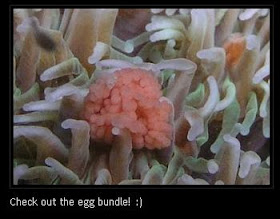Why is coral mass spawning in Singapore a big deal?
From Sex in the Tropics 2008 on the blooooooooooo blog
Coral mass spawning in Singapore was first recorded by Dr James Guest in 2002. It was the first record of coral spawning in the tropics. At least 18 different coral species from ten genera and five families (Acroporidae, Faviidae, Merulinidae, Oculinidae and Pectiniidae) have been observed to spawn in our waters! Mass spawning occurs on the third to fifth nights after the full moon between 8 and 10 p.m.In 2010, an international coral spawning workshop was conducted in Singapore, for the first time outside of the Caribbean. This is because more is known about coral spawning in Singapore than in other South-East Asian countries! The workshop is conducted by SECORE (SExual COral REproduction).
In interviews with the media, Dr James Guest emphasised that corals are part of Singapore's biodiversity and natural heritage. "There are 255 species of corals recorded here, and there may be some corals here that were around before Stamford Raffles arrived."
The fact that our corals mass spawn shows that our reefs are functioning well! According to Dr James, the number of coral species in Singapore that mass spawn is "as high as on other Indo-Pacific reefs, like the Great Barrier Reef... " This shows how rich Singapore's natural heritage is. We can find right at our doorstep: "diverse, functional and fascinating coral reefs, that people would normally associate only with countries like Australia."
What is coral mass spawning?
Some corals release their eggs and sperm all the same time. Called broadcast spawners, these mass spawning events usually occur once a year, a few nights after full moon. The eggs and sperm drift to the water surface where fertilization occurs.
After a few days, the embryos will have developed into coral larvae that drift about and eventually settle down to form new corals.
While bazillions of eggs and sperms are released during a mass spawn, most don't make it. Hordes of marine creatures gorge on the spawn, from fishes and crabs to jellyfishes. As the tiny coral larvae develop, they have to survive the countless predators that constantly sieve the water for plankton and edible bits. As well as many other challenges that we are still learning about. Excessive sedimentation, for example, can interfere with fertilisation and other aspects of coral larvae survival and successful settlement.
The SECORE Workshop in Singapore aims to find ways to cultivate the coral larvae in the lab, thus boosting their survival rate. The workshop is sponsored by Eco-Shape who are also trying to find the optimal conditions for coral growth, and how long coral polyps should be reared before being returned to the seabed. Their work may one day help with the restoration of damaged reefs.
Another important area discussed at the workshop was public awareness and education.
SECORE has a lively blog detailing all the gruesome and gruelling work done during the recent workshop. From sewing up the enormous nets to capture the spawn, collecting the spawn (1.5million coral eggs were collected!) and carefully handling and observing all the teeny tiny coral larvae. Plus the lectures, sharing and interviews with the many experts gathered for this event.
From the SECORE blog, here's a photo of our coral larvae that are only 5 hours old!

Have our corals spawned before?
Yes they have! Here are some awesome photos from previous years' mass spawning events.
Our corals spawned in Apr 2008! The above photo is by Karenne Tun from Nature in Singapore. More photos and stories on blooooooooooo and on Jeff's flickr.
 Wai blogged about her experience during the 2007 mass spawning event: part 1 and part 2.
Wai blogged about her experience during the 2007 mass spawning event: part 1 and part 2. Jani has this fabulous series of photos of the 2006 mass spawning event.
Jani has this fabulous series of photos of the 2006 mass spawning event. AND of the 2005 mass spawning event. Thanks Jani!
AND of the 2005 mass spawning event. Thanks Jani!
Read more about the 2010 coral spawning
- SECORE website and Singapore workshop with blog
- Singapore joins bid to save corals International workshop focuses on breeding habits by Grace Chua, Straits Times 7 Apr 10
- Spawning (in situ and ex situ methods) from Psychedelic Nature by Mei Lin
- Easter eggs from Raffles Museum News by fungi07
- SECORE Workshop - Coral spawning in Singapore (1-2 April 2010) from Psychedelic Nature
- SECORE workshop - setting up (Part 01) from ashira
- SPAWNED! from Raffles Science Institute
- SECORE workshop from Raffles Science Institute
- It's that time of the year again.... from ashira
Other links
- Sex in the Tropics 2008 on the blooooooooooo blog
- 'Tis the season for coral spawning by Chang Ai-Lien Straits Times 9 Apr 2002



No comments:
Post a Comment